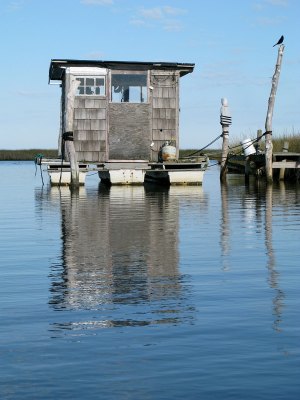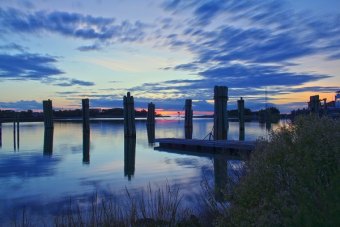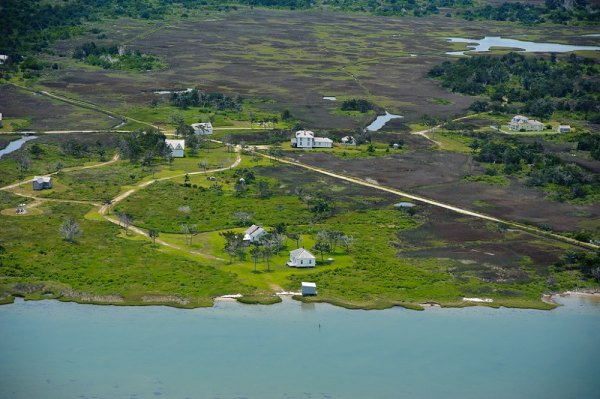Salty Souls and Connections
It was held on Ocracoke on January 24 & 25. The Saturday morning preaching was brief, and it inspired.
The big question on the table: what unites the communities between Whalebone Junction and The North River bridge in Carteret County? The obvious answer: certainly not Highway 12 and the Hatteras ferry, but boats, shoals, saltwater, and a certain crusty self-sufficiency.

Want to do a fun exercise? (No. Not that kind of exercise. A mental one.) Try to name 15 of the 21 communities along that route. Name all 21. Bonus question: How many of these communities are incorporated?
"If you're here, you're here because you want to be," observed Karen Amspacher, of the Core Sound Waterfowl Museum and Heritage Center. 59 participants conquered freezing rain driven by 50 mile per hour winds and battled late ferries to make it to the island in January. A few souls tempted fate on that drive between Stumpy Point and Engelhard. The hardy came on a skiff from Hatteras, captained by Barry Peele, Jr.
Peele, a charter boat captain with a notable heritage, will ferry you between Hatteras and Ocracoke. He wishes it could be free, but charges $25 for the first person, and $10 for each additional person. Reach Barry at 252-473-8301. What you get up to in Hatteras is your own business.
"Heritage tourism is good for a sense of pride in the culture," said Natalie Springuel of Maine Sea Grant. She spoke of "making multiple communities into one community without losing our individual character," and offered the example of the Downeast Fisheries Trail. "Do it because it is good for the health of your community, not just for tourist dollars."
After a day and a half of meetings, and fellowship that included a square dance ("Dive for the oyster!") some participants were making concrete plans to create a heritage trail uniting the region that could be marketed to visitors. Speaking of which, any volunteers to identify all the trails on Ocracoke? I can think of three, maybe four.
That was only one part of the conference. Sessions were also convened on local food, school partnerships, and small business development.
A group of about 10 educators from island schools reported that their assets and challenges were often one and the same. "Teachers wear many hats," and "Isolation"--which box do they go in?
The teachers offered truths about their communities, which share rapidly transitioning economies and environments.
"Almost overnight the shrimping fell out. I used to see doodles of trawlers, which they would be building. I don't see that anymore," said Margery Misenheimer, a middle school educator originally from Alexandria, Virginia, who has devoted her career to Smyrna Elementary students.

The group plans to create a formal exchange program with island schools from Maine, and to develop a platform for sharing lesson plans among NC coastal schools. As that curriculum develops, coastal heritage could be integrated into state standards. Learning, even with the expectation of yearly end of year tests, could be ever so much more hands on.
Some would suggest abolishing federal educational standards would save a lot of money and also do the trick, but that's another topic. Hi, Dad!
Food. Let's talk Food.
"Everybody eats," said Christy Shi of the Center for Environmental Farming Systems. Food is a catalyst that brings many people to the table, and there is a lot of economic potential around food.
Northeastern NC is entirely unrepresented on a map of the 25% of NC counties that have food councils. Like water and other utilities, food is necessary in planning, said Shi.
"There is the potential for the needs of coastal counties to provide a solution to the needs of inland counties," and vice versa, she said.
Fresh NC strawberries, tangelos and apples were all served--in January! Produce grown in dark mainland soil and seafood from clean brackish water: Healthy and delicious. Yes or no?
Now is an early opportunity to speak up if you want to participate in this conversation. The food group is focused, and planning how to involve stakeholders who represent the whole system, including planters, harvesters, fishermen, fish houses, processors, delivery people, and consumers such as restaurants, schools, groceries and food banks. Chew on this.
A primary purpose of the conference was to connect local people, businesses, and organizations with agency people, said Amspacher. They really did seem to want to help.
The NC Rural Center provides loans between $5000 and $250,000 to green businesses and non-profits. They work with both existing businesses and start-ups, can help those with less than perfect credit, and "love to fund for mom and pops."
Did you know that all community colleges in NC provide free business planning to all small businesses? I did not.
Both entrepreneurs and non-profits can access a variety of tools to help them "craft and sell" their idea, said Susan Sachs, who works with the Resourceful Communities Fund. "Fund your idea," she said. Match your needs with the source of a fund, shop it around, and don't give up.






